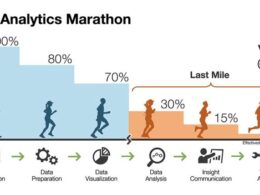This is an excerpt of the article below, focused on the topic above, preceded by an Executive Summary, by the author of the blog.
Getting Buy-In for Predictive Analytics in Health Care
Harvard Business Review
by Meetali Kakad, MD, Ronen Rozenblum, David Westfall Bates, MD
June 20, 2017
Executive Summary
by Joaquim Cardoso MSc.
Chief Editor of “The Health Strategy Foundation Blog”
@ The Analytics Informed Health Care Institute
March 15, 2022
What is the problem?
- According to the National Academy of Medicine (formerly the Institute of Medicine), the U.S. health care system spends almost a third of its resources — $750 billion annually — on unnecessary services and inefficient care.
What is the opportunity?
- New predictive analytics tools promise to reduce waste and improve care by forecasting the likelihood of an event — for example, a patient being readmitted to a hospital or developing a life-threatening infection — and allowing providers to tailor treatments and services accordingly.
- These tools are now being used across the continuum of care, from disease surveillance to chronic disease prevention to identifying patients who are at risk of deterioration.
What is the current adoption?
- Despite the tools’ power to improve care, most health care institutions are not yet using them.
What are the barriers?
- Among the impediments to adoption are the bewildering array of options providers face, (i) from mobile applications to (ii) web-based tools to programs that integrate with electronic health records.
- The most important factor is that “Success depends less on the tool itself than on getting buy-in at all levels from the start”, according to a survey with 34 key figures from leading U.S. health systems, policy makers, and predictive analytics vendors.
Among the most important findings of the survey, here are 3 lessons
- Engage the Right People from the Outset: Regardless of whether a provider is developing predictive analytics in-house, as many large academic medical centers have done, or purchasing tools off the shelf, managers should make sure they are involving the right people throughout the entire process.
- Change Agents and Clinical Champions Are Essential: Health care organizations that regularly used implementation experts to support change and improve quality across a range of IT and other types of projects had a head start when implementing predictive analytics.
- The C-Suite Must Commit: Just as important as frontline buy-in is engagement from the top, especially from the CEO. Organizational leaders are often unfamiliar with advanced analytics technology and applications.
What do we mean by “Engaging Clinical Champions and Change Agents — that are essential”?
Without a clear implementation plan and staff skilled in supporting behavior change, implementation of a predictive tool can stall.
We’ve found that health care organizations that regularly used implementation experts to support change and improve quality across a range of IT and other types of projects had a head start when implementing predictive analytics.
- These individuals work alongside clinicians to map workflows and identify what might need to change when introducing a new process or tool.
- They may have a clinical background or one in service redesign or quality improvement.
- Clinical champions have often proved to be essential in successful predictive analytics implementation — and health IT implementation generally.
Any group of change agents should include a subset of well-respected clinicians or other thought leaders in the organization.
- These individuals should actively reach out to promote the tool, demonstrating its use and educating people about its expected benefits.
Done well, the result can be an increase in high-value care — that is, targeting appropriate health care to those who need it.
ORIGINAL PUBLICATION (full version)

This is an excerpt of the article below, focused on the topic # 2(Engaging Clinical Champions and Change Agents — That are essential).
Getting Buy-In for Predictive Analytics in Health Care
Harvard Business Review
by Meetali Kakad, MD, Ronen Rozenblum, David Westfall Bates, MD
June 20, 2017
Table of Contents (TOC)
- Introduction
- Engage the Right People from the Outset
- Change Agents and Clinical Champions Are Essential
- The C-Suite Must Commit
According to the National Academy of Medicine (formerly the Institute of Medicine), the U.S. health care system spends almost a third of its resources — $750 billion annually — on unnecessary services and inefficient care.
New predictive analytics tools promise to reduce waste and improve care by forecasting the likelihood of an event — for example, a patient being readmitted to a hospital or developing a life-threatening infection — and allowing providers to tailor treatments and services accordingly.
These tools are now being used across the continuum of care, from disease surveillance to chronic disease prevention to identifying patients who are at risk of deterioration.
According to the National Academy of Medicine (formerly the Institute of Medicine), the U.S. health care system spends almost a third of its resources — $750 billion annually — on unnecessary services and inefficient care.
New predictive analytics tools promise to reduce waste and improve care by forecasting the likelihood of an event — for example, a patient being readmitted to a hospital or developing a life-threatening infection — and allowing providers to tailor treatments and services accordingly.
These tools are now being used across the continuum of care, from disease surveillance to chronic disease prevention to identifying patients who are at risk of deterioration.
But despite the tools’ power to improve care, most health care institutions are not yet using them.
Among the impediments to adoption are the bewildering array of options providers face,
- from mobile applications
- to web-based tools to programs that integrate with electronic health records.
To better understand what stands in the way of adoption, and what facilitates successful implementation, we interviewed 34 key figures from leading U.S. health systems, policy makers, and predictive analytics vendors.
Among our most important findings: Success depends less on the tool itself than on getting buy-in at all levels from the start.
But despite the tools’ power to improve care, most health care institutions are not yet using them.
Among the impediments to adoption are the bewildering array of options providers face, from mobile applications to web-based tools to programs that integrate with electronic health records.
Among our most important findings: Success depends less on the tool itself than on getting buy-in at all levels from the start.

HERE ARE THREE LESSONS:
Engage the Right People from the Outset
See the original publication
Change Agents and Clinical Champions Are Essential
Without a clear implementation plan and staff skilled in supporting behavior change, implementation of a predictive tool can stall.
We’ve found that health care organizations that regularly used implementation experts to support change and improve quality across a range of IT and other types of projects had a head start when implementing predictive analytics.
These individuals work alongside clinicians to map workflows and identify what might need to change when introducing a new process or tool.
They may have a clinical background or one in service redesign or quality improvement.
Clinical champions have often proved to be essential in successful predictive analytics implementation — and health IT implementation generally.
Any group of change agents should include a subset of well-respected clinicians or other thought leaders in the organization.
These individuals should actively reach out to promote the tool, demonstrating its use and educating people about its expected benefits.
At one leading public hospital in the Southern U.S., a small number of physicians helped promote the use of predictive models throughout the hospital.
Their work gave rise to a center for predictive analytics, and today the institution uses these tools in numerous ways, including to reduce readmissions and to identify patients at risk of sepsis or returning to the intensive care unit.
The C-Suite Must Commit
See the original publication
Done well, the result can be an increase in high-value care — that is, targeting appropriate health care to those who need it.
Done well, the result can be an increase in high-value care — that is, targeting appropriate health care to those who need it.
Originally published at https://hbr.org on June 20, 2017.












